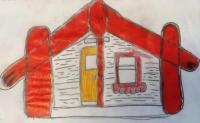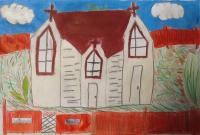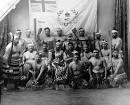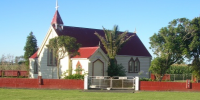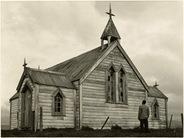Home-Shannon heritage
- History Of Shannon School
- Do You Remember the Time?
- Home Away from Home - Poutu Pa
- George Vance Shannon
- Edward Law 1864-1939
- Vogel Street
- Gunnings Go For It!
- Shannon Post Office
- Shannon Fire Station
- Shannon Railway Train Station
- Shannon Police Station
- A Mooing Hit and Miss
- The Shannon Bowling Club
- The Shannon Memorial Hall
- The Golden Days of Shannon Rugby
- Albion Tavern Shannon
- Club Hotel
- Renown Movie Cinema
- Mangahao Power to the People!
- Boxing - The Box Factory
- Flax Mills
- Our team
- Research process
- Learning outcomes
- References and acknowledgements
Home Away from Home - Poutu Pa
The Poutu Marae was built in 1876 next to the Manawatu River.
It was the Maori community house.
The sub-tribe Raukawa helped build the Poutu Marae and the Tainui waka.
Poutu Marae was built to serve the peoples of Ngati Whakatere, Ngati Ngarongo, Ngati Takihiku, Ngati Rakau and Ngati Turanga.
They all lived nearby in the 1830s.
The Whakatere people are great performers with a great kapahaka team. They won the New Zealand Kapahaka Championship in 1925. They defeated six other teams and held the shield in the place we now call Shannon.
Our tribe used two totara trees from Poutu Pa. Their names are Whangarae and Whangaihu. Later on they were chopped down. The tribe placed these two totara trees into the Manawatu River. The two totara drifed down the river. Our tribe used the left over timber to build the Turongo Church. This whare karakia still stands today at Poutu Marae. In 1930s the Turongo Church had fallen into disrepair, then finally rebuilt in 1937
Our Maori people fought many wars to protect our tribe.
The Ngati Whakatere warriors were great fighters and other tribes believed that the Ngati Whakatere people were being assisted and blessed by the god of war, Tumatauenga.
The services and transport were poor so the people of the Ngati Whakatere moved to nearby towns where there was work. This together, the Road’s Board made a decision to put a road through the hill were Turongo stood and possible put by the river, giving the impetus to move the little church to the Poutu marae. The Ngati Whakatere people are grateful of the number of Shannon citizens who helped move the little church, their name’s are Brian Moynihan and Mrs Flora and the Simpson family, Mr’s Jarret, Brain Clayton and Ronald Law.
We asked our Aunties: Aunty Maki and Aunty Mona.
Aunty Maki said that there were many trees before the Poutu Marae was built.
Back in Aunty Mona’s days our carver was Hokowhitu McGregor.
There were six or seven families that lived at Poutu Marae. The Rauhihi’s and the Ropoama’s.
Aunty Maki also mentioned that the marae kitchen had dirt floors with an open fire place.
They used a long drop to do their business instead of a flash flush toilet like we have today. The whanau (family) used to wash themselves in the nearby river.
In 1965 the children from Poutu Marae used to walk to school, there were no buses to pick up the children from the Poutu Marae.
The School helped the kapahaka team to go to the New Zealand Kapahaka Championship in 1931. The kapahaka team won the New Zealand Championships and Ngati Whakatere didn’t pay back the school’s money back until 1970!
Thank you everybody for sharing the exciting knowlege about our Poutu Marae. It’s important because we can build good relationships around community when we know more about ourselves and where we come from. Thank you!
Acknowledgments
Internet: Kete Horowhenua
From Bush and Swamp by Mrs Marjorie Law
Aunty Maki and Aunty Mona
Mrs Grace Nikolaison
Team effort by Isaac (Year 7) and Tane (Year 8).
POUTU PA
MOE MOEIA
According to history there was an old tohunga who had a dream about two logs. He dreamt that the two logs floated down the Manawatu river from Rangiotu and landed at Moutoa river bank.
WHARE KARAKIA
The Moutoa people found the logs and named them Whana Ihu and Whana Rae, these names are written on the gates as you enter the church way at Poutu Pa. The Moutoa people used the logs to build a church. The church still stands today and is named Turongo. Turongo Church sat on a hill at Moutoa around 1866. Then the church eventually moved to Whakatere-Poutu Pa in 1965 because cows got into the church and wrecked the inside and some people smashed the windows and the carvings were stolen. The Moutoa Iwi decided to move the church to where it is today, Poutu Pa.
POUTU PA
Back in the olden days Poutu used to have an open fire, where they used to cook their kai in big pots. Poutu did not have showers, they had a big well. They also never used to have flush toilets either, they had long drops. There were no flash wooden floors like now, only dirt floors.
KAI
If you want to know what kind of food they had, keep on reading.
They had meat, and this is how they prepared it. You would salt the meat and then hang the meat up on a tree branch. Then they would cut off the piece they wanted and would cook it in the open fire. There would be a big bowl underneath the meat for the dripping. They saved the dripping and used this to preserve the meat. They also had the Manawatu river to catch fish such as inanga, kahawai, mango, flounder and whitebait ( Mmmm YUMMY) ."They had huge vegetable gardens," said aunty Mona Anderson and nanny Maki Rauhihi.
Both aunty Mona and nanny Maki explained how everyone made their own butter and cheese, and had cows for milk.
TAMARIKI
By now your’e probably wondering what all the Tamariki were doing while the elders were working, well.... the Tamariki would usually play games e.g knucklebones, Jackstones, hopscotch, rugby, build huts, go fishing and climb trees.
KURA
The Tamariki walked all the way to school and back from Poutu Pa. The bus drove past Poutu Pa from Foxton too early for the kids to catch so they had to walk, aue! some kids had horses and they would go to school by horse.
POUKAI
Poukai is when the Tainui tribes come together with the Maori King. Poutu Pa have hosted the Poukai since 1979. The Poukai is a very important event for the community. Thanks to all the community people who always care enough to help with food such as meat, vegetables and much much more.
We have enjoyed learning about our Marae, Poutu Pa.
Acknowledgements
Interviewees: Nanny Maki Rauhihi, Whae Hui Sprott, Whae Eru Te Peeti, Nanny Mona Anderson.
From Bush and Swamp by Marjorie Law
Team effort by Adriana (Year 6) and Phyllisha (Year 6).

